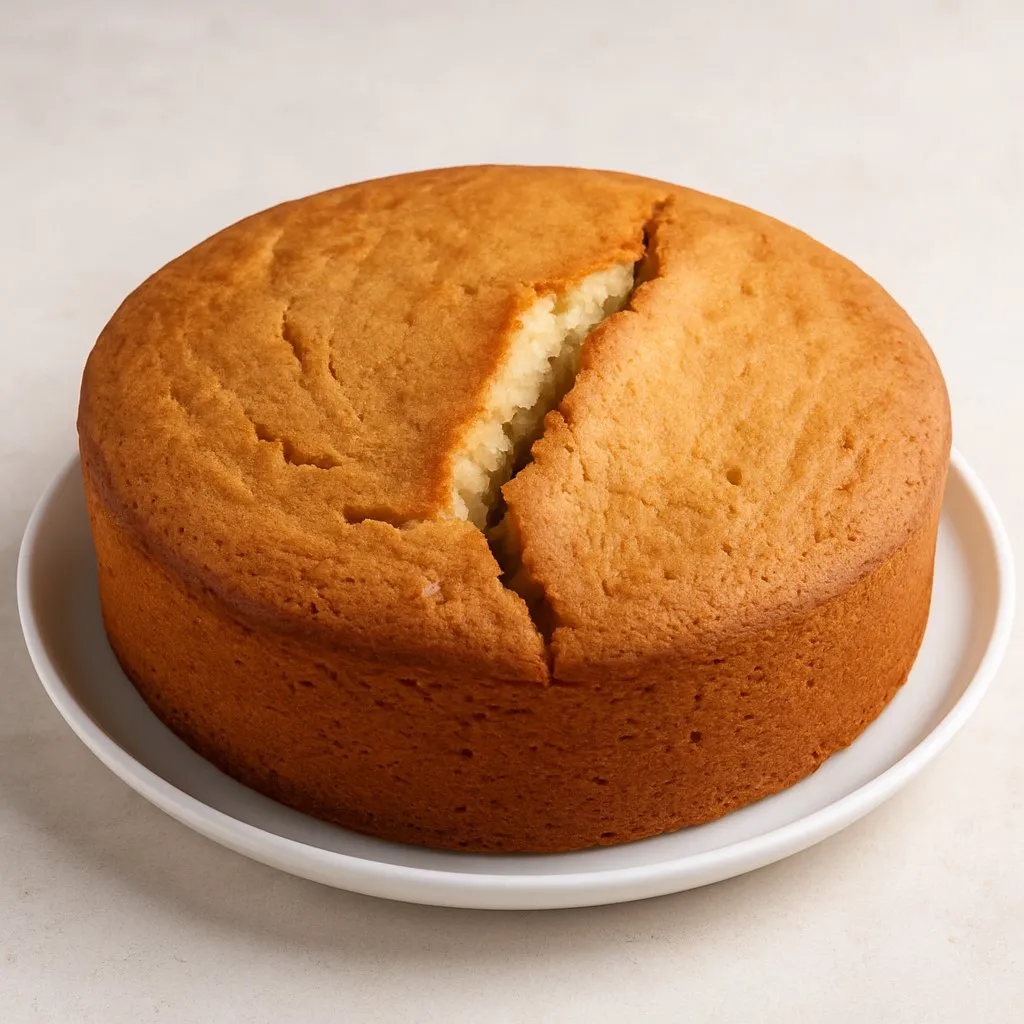Introduction
You take your cake out of the oven, only to find a deep crack running across the top. While it may still taste great, the uneven surface can be disappointing—especially if you wanted a smooth, professional finish. The good news: cake cracks are common and almost always preventable once you understand what causes them.
Why Cakes Crack
Cakes typically crack when the surface sets before the interior has finished rising. As the center expands, pressure and steam push upward and split the top. This usually stems from one or more of the following:
- Oven temperature too high
- Too much leavening
- Overmixed batter
- Wrong pan size or material
- Rack placement too high
Common Causes and How to Prevent Them
1) Oven Temperature Too High
A hotter-than-intended oven sets the crust quickly, so the interior bursts through and splits.
How to prevent: Use an oven thermometer and bake at the recipe’s temperature. If cracking persists, try 325°F (160°C) with a slightly longer bake time.
2) Too Much Leavening
Excess baking powder or soda causes an aggressive rise that the structure can’t support.
How to prevent: Measure with level teaspoons. Don’t substitute baking soda for powder (or vice versa) without a proper formula.
3) Overmixing the Batter
Overmixing incorporates too much air and develops gluten, leading to uneven rise and tougher crumb.
How to prevent: Once flour is added, mix only until combined. Fold by hand for the final strokes.
4) Pan Size (and Fill Level)
A too-small pan forces the batter to climb higher, increasing the chance of cracks; overfilling does the same.
How to prevent: Use the pan size specified and fill pans ½ to ⅔ full. Split excess batter into cupcakes.
5) Rack Placement and Airflow
Too close to the top element = fast browning and early crust formation.
How to prevent: Bake on the center rack for even heat. Avoid opening the door during the first two-thirds of baking.
Fixing a Cracked Cake
- Level the top with a serrated knife and proceed to frost.
- Invert the layer so the flat bottom becomes the top.
- Disguise with decoration: thicker frosting, ganache drip, cocoa or powdered sugar, fruit, or crumbs pressed on the sides.
- Repurpose: make a trifle, cake pops, or parfaits.
Pro Tips to Avoid Cracks Every Time
- Preheat fully; don’t rush batter into a warming oven.
- Consider “low and slow”: a slightly lower temperature for a bit longer.
- Use light-colored pans for gentler heat.
- If your oven has hot spots, rotate pans in the last third of the bake (not earlier).
- For tall layers, try cake strips (damp insulating bands) to cool pan edges slightly and promote even rise.
Practical Example: Smooth, Crack-Free Vanilla Cake
Mix gently, pour into correctly sized pans filled no more than two-thirds, and bake at 325°F (160°C) on the center rack. Begin doneness checks a few minutes early. A toothpick should come out clean or with a few moist crumbs. You’ll get a level, golden surface that frosts beautifully.
Frequently Asked Questions (FAQ)
Q1: My cakes only crack in the center. Why?
Usually the oven runs hot or the top sets too soon. Lower the temperature by 10–25°F (5–15°C), bake on the center rack, and verify pan size and fill level.
Q2: Do cake strips really help?
Yes. Soaking cake strips and wrapping them around pans insulates the edges, slowing edge bake so the center rises more evenly—reducing domes and cracks.
Q3: Convection or fan-forced ovens crack my cakes. What should I change?
Reduce temperature by ~25°F (15°C) and monitor earlier. Strong airflow can set surfaces quickly; if possible, use conventional (no fan) for delicate cakes.
Q4: Dark or glass pans vs. light metal—does it matter?
Dark and glass pans absorb more heat and brown faster, increasing crack risk. Use light-colored aluminum, or reduce temp by ~25°F (15°C) if using dark/glass.
Q5: How full should I fill the pan to avoid cracking?
Fill ½ to ⅔ full. Overfilling encourages doming and splitting. With extra batter, make cupcakes instead of forcing it into the pan.
Q6: Will resting the batter help?
For typical butter cakes, bake promptly once leaveners are mixed with liquids. Resting can reduce lift or alter texture. (Chiffon/angel/foam cakes are different—follow their specific methods.)
Q7: I lowered the temperature and still get cracks. Now what?
Check leavening freshness and quantity, confirm your oven with a thermometer, use cake strips, and verify that you’re not overmixing or overfilling the pan.
Q8: High altitude is causing cracks. Any adjustments?
At altitude, reduce sugar slightly (1–2 tbsp per cup), reduce leavening a bit (⅛–¼ tsp), and consider a slightly higher oven temp with a shorter bake. Follow tested high-altitude recipes when possible.
Q9: Can I score the top before baking to “control” the crack (like in bread)?
Not for cakes. Scoring is a bread technique. Proper temperature, leavening, pan choice, and mixing are the right fixes for cakes.
Q10: Does less sugar mean fewer cracks?
Not necessarily. Sugar helps retain moisture and softens structure. Too little can make a drier, firmer crust that’s also prone to splitting. Keep to tested ratios.
Conclusion
Cracked cakes are frustrating but fixable—and, with a few adjustments, preventable. Control oven temperature, measure carefully, choose the right pan and fill level, minimize early door openings, and consider cake strips for even rise. With these habits, your cakes will bake up smooth and photo-ready—every time.

